Water Lettuce and Water Fern in Nile Tilapia Diets
A Trial to Improve the Utilization of Water Lettuce (Ulva Lactuca) and Water Fern (Azolla Pinnata) in Nile Tilapia (Oreochromis Niloticus) Diets
Published: May 8, 2012
By: Eman H. Labib (Animal Prod. Research Institute), Hafez A Mabrouk (National Institute of Oceanography and Fisheries) and Zaki, M. A.(Alexandria University)
ABSTRACT
Two separate experiments (1 and 2, respectively) were conducted in order to investigate the susceptibility of using dried Ulva (Ulva lactuca) meal (DUM) and dried azolla (Azolla pinnata) meal(DAM) with or without Sodium hydroxide (NaOH) treatment in Nile tilapia (Oreochromis niloticus) feeding. Nine experimental diets (30% crude protein) were processed; four containing 10% DUM for the first experiment and another four diets containing 20% DAM for the second experiment, where DUM and DAM were treated either with 0, 1, 2, or 3% NaOH, and one control diet without DUM or DAM for both experiments. Each diet was applied to the experimental fish in the 1st and 2nd experiments in triplicate groups of 10 fish (2.79 ± 0.014 g, Av.± SE) per aquaria (100 l) for 84 days. Fish were fed the experimental diets three times daily (six day a week) at a daily feeding rate of 3% of live body weight until the end of the trial. The results show that growth performance of fish fed diets containing 10 %DUM and 20% DAMwith 3.0 % NaOH treated were significantly (P<0.05) different than those fed control diet. Increasing NaOH treatment concentration percent for DUM or DAM increased fish feed intake (FI) (g/fish), protein efficiency ratio (PER), protein productive value (PPV %), energy utilization (EU %) and improved feed conversion ratio (FCR). Chemical composition of fish fed either DUM or DAM illustrated that differences were not significant (P<0.05) between fish fed treated or untreated in dry matter and crude protein. Increasing NaOH concentration treatment from 1% up to 3% lead to decrease in fat and ash contents in fish, while energy content was not significantly affected (P<0.05). There was no significant different (P<0.05) in fat content between fish fed diets containing DUM, while it was significant (P<0.05) between fish fed DAM diets and the higher fat content was recorded in fish fed DAM involved diet treated with 1% NaOH . In general, and based on the obtained results it could be concluded that Nile tilapia Oreochromis niloticus) can utilize of dried Ulva (Ulva lactuca) meal(DUM) at a level of 10 % or dried azolla ( Azolla pinnata) meal (DAM) at a level of 20 % with sodium hydroxide (NaOH) treatment at a level 3.0 in the diet instead of plant protein without any adverse effecton fish health.
Key words: DUM, DAM , Sodium hydroxide, Plant protein source.
INTRODUCTION
The most important raw material used in the fish feeds is fishmeal for its high protein content, good amino acid balance, lack of anti-nutrients and high palatability. However, because of its high cost and limited resources, its substitution is a basic prerequisite for the sustainability of aquaculture. Feedstuffs that can be used to replace fishmeal are very limited, as they usually have deficiencies in essential amino acids and contain growth inhibitors. Dietary completion and technological treatment of plant feedstuffs could increase their use in fish feeds and may reduce reliance on fish products. (Mbonge, 2007).
Although a large amount of protein feedstuffs has been used in domestic animal feeds, relatively few have been used in fish feeds, because fish require high levels of dietary protein and low levels of fiber Shiau and Peng (1993).Numerous works have been reported on the possible use of plant proteins in fish feeds (Abdul-Aziz, 1998 ; Soltan, 2002 and Soltan,2005). The extent of plant protein utilization depends on availability, acceptability by fish, ease of processing, and nutritive value. However, high levels of plant proteins in fish diets have, in some cases, resulted in reduced growth and poor feed efficiency and this probably is the result from improper balance of essential nutrients, such as amino acids and minerals, presence of toxic substances or antinutritional factors, or decrease of palatability and pellet water stability value (Lim and Dominy ,1989). On the other hand, green plants have long been recognized as the cheapest and most abundant potential source of proteins because of their ability to synthesize amino acids from a wide range of virtually unlimited and readily available primary materials (Fasuyi and Aletor, 2005).
Seaweeds are increasing receiving consideration in fish feeding for their high protein contents, essential amino acid content, vitamins and trace metals (Güroy et al., 2007).Ulva species are particularly rich in rare cell-wall polysaccharides and have been proposed as being an important source of dietary fiber, mainly soluble fiber (Lahaye and Axelos 1993).Ulva lactuca is also a good source of Vitamin A, B2, B12, and C and is rich in γ-tocopheroland U. lactuca extracts have been shown to exert antioxidant, anti-microbial, and anti-viralactivities in various in vitro assays (Ortiz et al., 2006; Abd El-Baky et al., 2008). Ulvalactuca was characterized as low-energy high-nitrogen seaweed (Copertino et al., 2008).
Because Azolla spp. has a higher crude protein content (ranging from 19 to 30%) than most green forage crops and aquatic macrophytes and a rather favorable essential aminoacid (EAA) composition for animal nutrition (rich in lysine), it has also attracted theattention of livestock, poultry and fish farmers (Cagauan and Pullin, 1991). On the other hand, Azolla develops an endosymbiotic relationship with blue green algae, thus Anabaenaazollae (Lisa et al., 2002) which live in the dorsal lobe cavity of the leaves. This communityis composed of two types of prokaryotic organisms: one species of nitrogen-fixingfilamentous cyanobacteria-Anabaena azollae and a variety of bacteria that some identified as Arthrobacter sp . and associate with others showing the presence of nitrogenase (Costa et al., 1994).
The main purpose of the present study was to evaluate the affect of NaOH treated seaweed, Ulva lactuca and fresh water fern, Azolla pinnata as feed ingredients on the growth performance, feed utilization, and body composition of Nile tilapia ( Oreochromis niloticus) fingerlings.
MATERIALS AND METHODS
Fish and culture facility
Two separate experiments (1 and 2, respectively) were carried out to evaluate the validity of using 10% DUM and 20% DAM without or with NaOH treatement in diets Niletilapia O.niloticus fingerlings. Fish were acclimated to the experimental system for 14 days before starting the experiments. Thereafter Nile tilapia were placed randomly in twenty glassaquaria (ten glass aquaria /each exp.) with dimensions of 100×40×30 cm and 100 l capacityof water /aquarium, triplicates per treatment were used in this study. Each aquariumcontained ten fingerlings of Nile tilapia with an average initial body weight of 2.79 ± 0.014 g/fish.
Preparation treatments
Whole plants of Ulva lactuca and Azolla pinnata were harvested in sufficient quantities from Anfoushy Sea Coast and Abis Faculty of Agriculture experimental farm, respectively. It was sundries for three days until they became crispy while retaining their greenish coloration. Then, both dried Ulva meal (DUM) and dried azolla meal (DAM) were divided to four groups; untreated group and three groups treated with NaOH at (1, 2 and 3%) then after DUM and DAM treated with NaOH were minced and oven dried at 60-80°C for 48hrs.
Experimental diets
Nine experimental diets, 30% crude protein, were formulated, Control Diet without (DUM or DAM) used in 1st and 2nd experiments. Diets No.1, 2, 3 and 4 contained 10%DUM treated with different concentrations of NaOH (0, 1, 2 and 3% ), respectively (inexp.1) and diets No.5,6,7 and 8 contained 20% DAM treated with different concentrations of NaOH (0,1, 2 and 3 % ), respectively (in exp.2) as described in Table (1). Each ingredientwas ground and thoroughly mixed with the other dietary ingredients, vitamins and minerals mixtures. A few drops of oil was added at the same time of mixing with warm water (45°C)which was slowly added until the diets began to clump. Diets were processed by a California pellet mill machine and dried for 48 hrs at 70°C in a drying oven. The experimental pellets were soft enough for the fish to take and retain. The processed diet particle size was 0.6 mmin diameter and 2 mm - length. Fish in each aquarium were fed three times daily (six days aweek) at a rate of 4% of body weight for 84 days.
Heavy metal
From the triple digested sample, copper (Cu), iron (Fe), manganese (Mn), zinc (Zn),chromium (Cr) and nickel (Ni) were determined in both Ulva lactuca and Azolla pinnata(mg/ kg DM) using a par king Elmer atomic absorption spectro photometer (AAS) (Model5000, Pperkin E Lemer, USA).
Water quality
Determined water quality parameters in the experimental glass aquaria in 1st and 2nd experiments were determined according to the methods of APHA ,(1992). The concentrations of ammonia, total alkalinity, nitrate, nitrite were determined according to Boyd, (1979). Ammonia and nitrite were measured at weekly intervals , while water temperatures were recorded daily in each aquaria .Also, dissolved oxygen was measured daily by oxygen meter and pH by pH meter.
Proximate Analysis of Diet and Fish
At the start of the experiment, 40 fish were taken and kept frozen for the chemical analysis. At the end of the experiment, the basal diet and fish samples from each treatment were chemically analyzed according to the standard methods of AOAC, (2000). The neutral detergent fiber (NDF) and acid detergent fiber (ADF) were determined according to Van Soest et al., (1991). Gross energy (GE) and energy content were (Eco)calculated from (NRC,1993) as 5.65, 9.45, and 4.1 kcal/g for protein, lipid, and carbohydrates, respectively.
Statistical Analysis
Statistical analyses of growth performance, feed utilization and carcass composition was made between treatments groups using MSTAT-C 4 package (Nissen,1987) and Duncan´s Multiple range test of the same program to determine standard differences (P<0.05) between treatment means.
RESULTS
Water quality
All water quality parameters tested throughout the experimental period revealed thatall parameters were within the permissible levels for optimum Nile tilapia growth .The mean values of water quality parameters in 1st and 2nd experiments for the complete rearing period were ranged as following : water temperature ranged from 23 to 29.3 °C), dissolved oxygen from 4.8 to 5.65 mg/ L), pH from 7.2 to 7.89 ), total ammonia (0.10 to 16 mg/ L), nitrite(0.05 to 0.07 mg/ L), total alkalinity from (156 to 167 mg/ L). All these values were within the permissible limits in water aquarium for Nile tilapia maximum growth .These results arein accordance with finding of Abdel-Hakim et al .,(2008) working with Mono sex Niletilapia.
Experiment 1:
Results of Table (2) illustrate the chemical analysis (%) of dried Ulva meals (DUM) before and after treatment used in the 1st experiment. Increasing level of treatment DUM with NaOH from 0, 1, 2, to 3%, increased dry matter, crude protein, ether extract, ash andgross energy contents. However, crude fiber, neutral detergent fiber (NDF), acid detergent fiber (ADF), nitrogen free extract (NFE) and gross energy were decreased.
Heavy metals (mg/ kg DM) of DUM before or after treatment by NaOH is shown inTable(3) Increasing level of DUM treatment with NaOH from 0, 1, 2, to 3% resulted in aslight decrease in concentrations of heavy metals (Cu, Fe, Mn, Cr and Ni (Mg/Kg DM) compared with the untreated DUM. Results in Table (4) show the chemical analysis of the five tested diets used in the 1 st experiment. Treatment of DUM with NaOH at the levels 0, 1, 2 and 3% increased crude protein, ether extract, ash content and nitrogen free extract and gross energy while crude fiber content decreased. On dry matter basis, EE% and Ash% of DUM with 3% NaOH were higher than the control diet (without DUM). However crude protein, crude fiber, nitrogen free extract and gross energy were less than control diet without DUM.
Average values of initial and final weights and growth performance parameters (total weight gain, average daily gain (ADG g / fish / day) and specific growth rate (SGR% / day) are presented in Table (5). Results revealed that averages of body weights (2.79g) were different among the experimental groups at termination of the experimental period. Treatments applied released significant differences in final weights among the groups where control diet without DUM group showed heavier final weight followed in a decreasing order by fish fed diets containing DUM with 3, 2, and 1 % NaOH, respectively. The same trend was observed in ADG and SGR% values, where the highest SGR% value was obtained byfish fed diet containing DUM treated with 3% NaOH and the lowest was observed in fish fed diet containing DUM without treatment.
Average values of feed and nutrient utilization parameters including feed intake(FI), feed conversation ratio (FCR), protein efficiency ratio (PER), protein productive value(PPV%) and energy utilization (EU%) are illustrated in Table ( 6 ). Results revealed that the highest FI (p<0.05) was observed in fish fed diet containing DUM treated with 3% NaOH(66.70 g/fish), however this value was less than the control, while the lowest FI was observed in fish fed diet containing DUM without treatment (51.98 g/fish). On the other hand, the best FCR values were obtained by the fish fed diet without DUM (2.49). Inaddition, it was observed that increasing NaOH percentage in treatment of DUM improvefeed intake significantly (p<0.05). On the other hand, diet without DUM recorded the highest PER value followed in a decreasing order by the other treatment groups, while the diet containing untreated DUM showed the lowest PER value. The same trend was observed inPPV%, where the fish fed diet without DUM showed the highest PPV% value, while the fishfed diet containing DUM without treatment recorded the lowest PPV% value.
Carcass composition analysis of Nile tilapia fingerlings fed diets included DUM without or with treatment at different concentrations of NaOH is summarized in Table (7). Dry matter (DM), crude protein, (CP), ether extract (EE) and energy contents (ECO) were almost similar for all groups, indicating that they were not significantly (p> 0.05) affected by dietary treatments. On the other hand, ash content was significantly (p<0.05) affected where it increased with increasing NaOH treatment level.
Heavy metals contents (mg/kg DM) of Nile tilapia muscles, at start and end of the experiment, are summarized in Table (8). Results indicated that heavy metals concentrations in Nile tilapia muscles at start were less than at end. The results showed that increasing concentration of NaOH in treating DUM lead to a significant decrease (P<0.05) in Fe, while decreasing Zn was not significant (P<0.05). On the other hand, treating DUM did not affect concentration of Cu and Mn significantly (P<0.05).
Experiment 2:
Table (9). illustrates that chemical analysis (on dry matter basis) of DAM before treatment with NaOH contained: 25 % CP , 3.9 % EE , 14.1 % CF, 42.7 % neutral detergent fiber (NDF) , 33.4 % acid detergent fiber (ADF) , 12 % ash, 45.1 % nitrogen-free extract and gross energy (GE) 363.6 kcal 100g -1 . Crude protein, ether extract, Ash, nitrogen-free extractand gross energy of NaOH treated DAM were higher than untreated and increasing NaOH concentration lead to increase DM, CP, EE, ash, NFE and GE, while CF, NDF and ADF decreased.
Heavy metals concentrations (mg kg -1 on DM basis) in DAM before or after treating with NaOH are shown in Table (10). Copper concentration (Cu), iron (Fe), manganese (Mn), zinc (Zn), chromium (Cr), and nickel (Ni) were 6.53, 45.12, 9.74, 23.25, 1.88, and 0.135(mg / kg DM) in DAM without treatment. It was observed that increasing NaOH treatment concentration from 1 up to 3% decreased DAM heavy metals content.
Results in Table (11) showed chemical analysis (% on DM basis) of the five experimental diets used in the 2nd experiment. It was observed that treatment DAM (20% of the whole diet) with different concentrations of NaOH (1, 2, and 3%) decreased CP, EE, Ash, NFE and GE contents, while crude fiber content increased. On the other hand, it was observed that ether extract, CF, NFE and GE of DAM involved diet treated with 3% NaOH was lower than control diet; while ash content was higher and crude protein was similar.
Growth performance data of Nile tilapia fingerlings fed DAM included diets treated or untreated with NaOH are summarized in Table (12). Growth performance parameters were observed to be significantly (P<0.05) higher with fish fed treated DAM included diets than fish fed untreated DAM included diets. The highest significant (P<0.05) final weight (33.12g / fish) was obtained with fish fed treated DAM included diet with 3% NaOH, followed byfish fed 2% NaOH treated DAM included diet and then 1% NaOH treated DAM included diet. The lowest final weight (23.81g / fish) was obtained with fish fed DAM untreated included diet. ADG and SGR showed the same trends.
Feed and nutrients utilization of the experimental Nile tilapia fingerlings fed experimental diets are summarized in Table (13). Feed intake was significantly higher (P>0.05) in fish fed DAM (3% NaOH treated) included diet. On the other hand, no significant difference (P<0.05) were observed between control diet and 2% NaOH treated DAM included diet in feed intake. Differences in feed conversion ratio (FCR) were not significant (P>0.05) between fish fed DAM included diet treated with 3% NaOH and fish fedcontrol diet (without DAM). In addition, it was observed that the exposure of DAM to increasing concentration of NaOH, from 1% up to 3%, increased feed intake (FI), protein efficiency ratio (PER), protein productive value (PPV%), energy utilization (EU %) and improved feed conversion ratio significantly (P<0.05).
Carcass composition analysis of whole body of Nile tilapia fingerlings fed NaOH treated or untreated DAM included diets are summarized in Table (14). Dry matter, crude protein, and ash contents of fish carcass were almost similar for all groups of fish, indicating that they were not significantly (P>0.05) affected by dietary treatments. On the other hand,ether extract and energy content were significantly affected (P<0.05). However, increasing NaOH concentration in DAM treatment decreased ether extract and energy content.
Heavy metals concentrations (mg / kg DM) in Nile tilapia muscles at start and end of the second experiment are summarized in Table (15). Results show that heavy metals (Cu,Fe, Mn, and Zn) concentrations in fish muscles at start were less than at the end of the experiment. Furthermore, Heavy metals concentrations in fish fed on control diet (withoutDAM) were less than other diets contained DAM treated or untreated with NaOH. . Results also revealed that treating DAM with NaOH significantly (P<0.05) reduced heavy metals(Cu, Fe, Mn, and Zn) concentrations in fish muscles compared with DAM without NaOH.
DISCUSSION
Experiment 1:
The result on chemical composition and feeding effect to Ulva meal are presented and discussed under the following subheading and presented in the Table (2) . The dry matter of Ulva lactoca was 95.55 % , the crude protein was found 19.9 %., ether extract content was6.20 % ,crude fibre level was 14.10 %., Nitrogen free extract (NFE) content was 44.70 %and Ash content was 15.10 % . The results are similar with earlier observation of El-Ebiary,(2002). On the other hand The results are disagreeing with Ventura and Castañón (1989).Sebahattin (2009). In nature, herbivorous fish may benefit from ingestion of many species of macro-algae (Montgomery et al ., 1989). Macroalgae are used in aquaculture as feed component and in remediation. Green seaweed (Ulva spp.) have been found to be suitable for feeding fish and the use of algae in aquaculture has also been recently reviewed by Turan,(2009). Several feeding trials have been carried out to evaluate algae as fish feed. Algae have been used fresh as a whole diet and dried algal meal has been used as a partial or complete replacement of fishmeal protein in pelleted diets.
The results of the earlier studies showed that the performances of fish fed diets containing 10–20 percent algae or seaweed meal were similar to those fed fishmeal based standard control diet, and only about 10–15 percent of dietary protein requirement can bemet by algae without compromising growth and food utilization. These studies illustrated that there was a progressive decrease in fish performance when dietary incorporation of algalmeal rose above 15–20 percent (FAO, 2009).
According to Davies (1985), it have been shown that high levels of fiber content in the diets of many finfish species impede and reduce growth and that high crude fiber content can reduce the pelleting quality of the feed. For tilapia, Anderson et al., (1984), concluded that dietary fiber levels above 5% reduce food utilization, digestibility and protein utilization. In the present study, fiber content in the experimental DUM included diets ranged between 7.9-9.72 .In concern of nutritional value, Mensi et al ., (2005) reported that it is possible to completely substitute maize meal for algae meal at the level of 27% in a diet with about 50%of soybean meal, and obtain similar values for digested energy (DE) and digested proteins(DP), when approaching this level, total mineral values become a limiting factor. Up to alevel of 27%, protein/energy (P/E) ratios decrease. Furthermore, Wassef , (2005) found that feeding Sparus aurata and Dicentrarchus labrax fries, under aquaria conditions, Ulva mealtest diets at 5% level produced significantly (P<0.05) higher percent weight gain, daily weight gain and survival rate compared to Control group and the increase was approximately 2.5-3 folds that of control group. On the other hand, the author concluded that using Ulva meal test diets at 5% level improved feed intake, protein intake, feed conversion ratio, and resulted in highest protein productive value, whereas PER was unaffected significantly(P<0.05). Zaki et al., (1994) reported that inclusion of seaweeds treated with NaOH in fish diets had improved growth of fish. On the contrary, other reports indicated poor growth with the inclusion of seaweeds (Zaki and El-Ebiary, 1997) they attributed the poor growth performance achieved to the higher seaweeds inclusion levels (more than 10%).
In the present study, growth performance parameters (final weight, weight gain,ADG (g/fish/day) and SGR %/day) and feed and nutrient utilization parameters (FI, FCR, PER, PPV% and EU%) in control group were better than other groups fed DUM either treated or not, and this may be attributed to high levels of fiber content presented in DUM. Furthermore, growth performance and feed and nutrient utilization were improved with increasing NaOH treatment levels for DUM included in experimental fish diets. In agreement with the obtained results, Kalla et al., (2008) reported that the addition of Porphyraspheroplasts to red sea bream diet improved SGR. In addition, Valente et al., (2006) recorded improvements in SGR when dried Gracilaria busra-pastonis replaced The result are almost similar with % of a fish protein hydrolysate diet for European sea bass. However, reduced growth responses were recorded with increasing inclusion of algae in fish diets(FAO, 2009).
Experiment 2:
The result on chemical composition and feeding effect to Azolla meal are presented and discussed under the following subheading and presented in the Table (9).The dry matter of Azolla was 94.70 %. The results are almost similar with earlier observation of Ali and Leeson (1995).The crude protein level of Azolla was found 25.0 %. The result are almost similar with, Singh, (1977) reported that the crude protein might vary from 25-37.36 %.Ether extract content of Azolla was 3.90 %. On the other hand, Buckingham et al., (1978)reported 5.1 %. Crude fibre level in Azolla meal was 14.10 %. The results are similar withthe earlier observation of Querubin et al., (1986) for Azolla pinnata. Nitrogen free extract(NFE) content of Azolla sample was 45.10 % . The result is similar with the observation of Ali and Leeson (1995); Ash content of Azolla was 12.00 %. The results are consistent with Buckingham et al., (1978) who reported 15.50 percent of ash in Azolla pinnata.
Fresh water algae and aquatic macrophytes were tested in tilapia diets. Published evidences on Azolla nutritive value to fish show inconclusive results. Some reports showed improved growth with the inclusion of Azolla (Santiago et al. , 1988; Tharwat, 1999). In agreement, in the present study it was observed that growth performance parameters recorded significantly (P<0.05) higher values with fish fed treated DAM included diets comparing with fish fed untreated DAM included diets. On the contrary, other reports indicated poor growth with the inclusion or fresh added of Azolla ( Zaki and El-Ebiary, 1997;Fiogbé et al., (2004) ; El-Sayed , (2008) ; and Abdel-Tawwab, (2008) who attributed the poor growth performance achieved to the higher Azolla inclusion levels. The poor growth of fish fed on diets containing higher levels of Azolla may be attributed to excesses or deficiencies of amino acids, according to Fiogbé et al., (2004) which found to cause a depression of food intake, protein synthesis and growth as concluded by Cole and VanLunen (1994).
Tangendjaja et al ., (1990) reported that when Crude fiber content of dried Azolla meal does not exceed or equal. In the present study, values of crude fiber did not exceed crude protein content before or after treatment at any level, which indicate that experimental diets crude proteins were well digested. On the other hand, Fiogbé et al ., (2004) noted that mixing Azolla with some agricultural by-products such as rice bran; fermentable by-products such asyeasts; or the addition of purified enzymes; might improve ingestion and digestibility of Azolla . In the present study, Azolla was dried and included as feed ingredient (20%) in the experimental diets as shown in Table 1. which indicate that the experimental diets were prepared as recommended. Carcass compositions of fish were reported to be markedly affected by feeding with Azolla Antoine et al ., (1986) observed that when fish fed with fresh Azolla , both O. niloticus and C. melanurum had higher moisture and lower lipid concentrations. In carcass the present study´s moisture data are in contrast with Antoine et al ., (1986) observations, but in agreement with regard to lipid content. On the other hand, El-Sayed , (1992) reported that carcass protein content was negatively correlated with Azolla levels in the diets, while the other workers and the present study recorded no effect on carcass protein content.
Based on the obtained results from the 2nd experiment , it could be concluded that reports on the use of Azolla in aquaculture are extremely limited and its value as a fish feed is still needs more studies. Regarding to the present study, it could be concluded that: 1) dried Azolla and Ulva meals could be used in Nile tilapia feeds as dietary ingredient at levels less than 20% to avoid the higher crude fiber content in processed diet. 2) dried Azolla and Ulvameals need more than Sodium Hydroxide treatment in order to reduce fiber content which hamper protein digestibility. 3) dried Azolla could be used in feeding fish as compost regarding to the endo-symbiotic relationship with blue green algae, Anabaena azolla which composed of cyanobacteria -Anabaena azollae and Arthrobacter sp .
CONCLUSION
In general, and based on the obtained results from 1st and 2nd experiments it could be concluded that Nile tilapia (Oreochromis niloticus) can utilize of dried Ulva (Ulvalactuca) meal (DUM) at a level of 10 % or dried azolla (Azolla pinnata) meal (DAM) at alevel of 20 % with sodium hydroxide (NaOH) treatment at a level 3.0 % in the diet instead of plant protein (soybean meal) without any adverse effect on fish health.
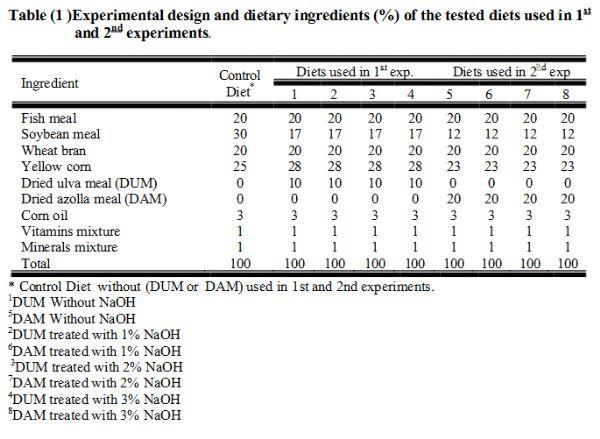
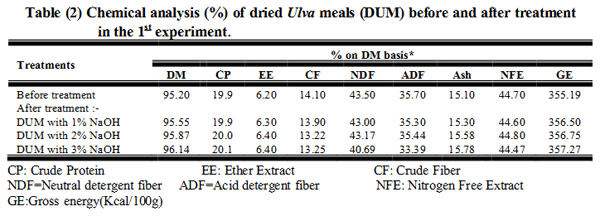



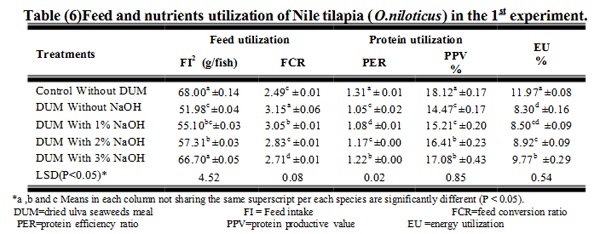
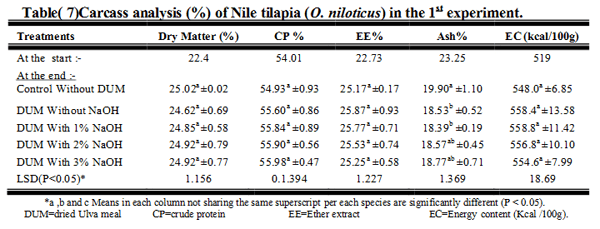
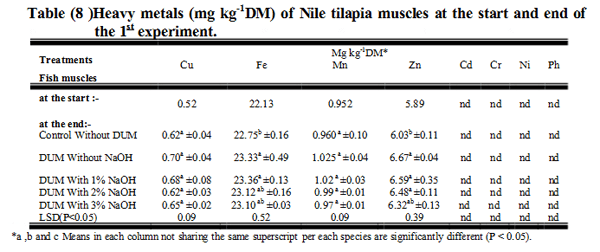
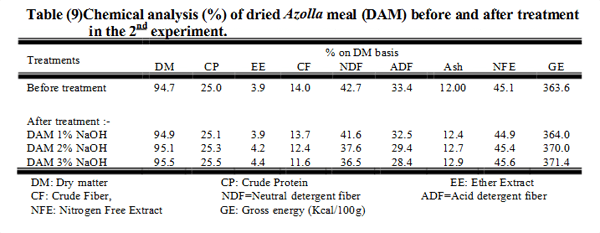

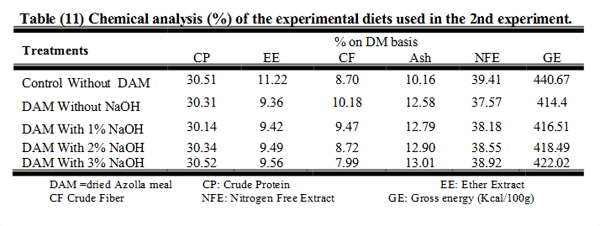
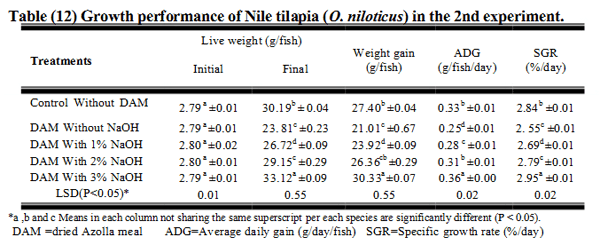
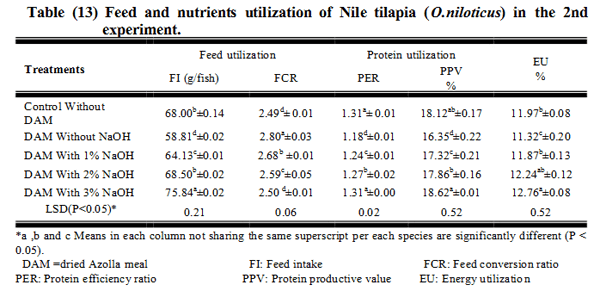
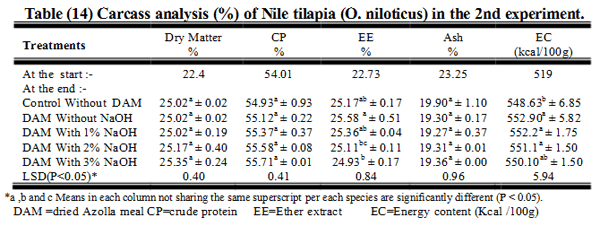
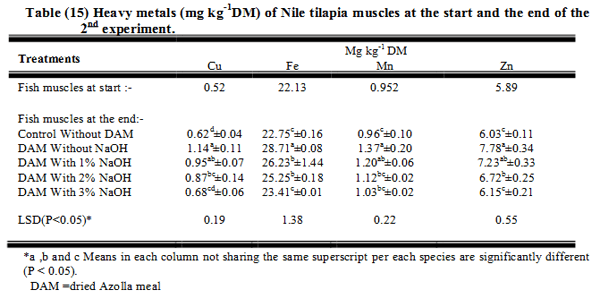
REFERENCES
Abd El-Baky,H.H ; F.K. El Baz and G.S. El-Baroty (2008). Evaluation of marine alga Ulvalactuca L. as a source of natural preservative ingredient. EJEAFChe 7:3353–3367.
Abdel-Hakim,N. F.; M. E. Lashin, A. Al-Azab and H. M. Nazmi (2008). Effect of replacingsoybean meal protein by other plant protein sources on growth performance andeconomical efficiency of mono sex Nile tilapia ( Oreochromis niloticus ) cultured intanks. 8 th International Symposium on Tilapia in Aquaculture 2008.P.739-755.
Abdel-Tawwab, M. (2008). The Preference of the Omnivorous–Macrophagous, Tilapia zillii (Gervais), to Consume a Natural Free-floating Fern, Azolla pinnata . Journal of theWorld Aquaculture Society, Volume 39, Issue 1, pages 104–112, February 2008.
Abdul-Aziz, G.M.; M.A. El-Nady; A.S. Shalaby and S.H. Mahmoud (1999). Partialsubstitution of soybean meal protein by different plant protein sources in diets for Nile tilapia fingerlings .Bull.Fac.Agric.,Cairo Univ.,50:189-202.
Ali, M.A. and S. Leeson, (1995). The nutritive value of some indigenous Asian poultry feedingredients. Anim. Feed Sci.and Tech., 55:227-237
Anderson, J.; A.J. Jackson ; A.J Matty and B.S. Capper(1984). Effects of dietarycarbohydrate and fiber on tilapia O. niloticus . Aquaculture, 37: 303-314.
Antoine, T.;S.Carraro; J.C. Micha, and C. Van Hove (1986). Comparative appetency for Azolla of Cichlasoma and O. niloticus . Aquaculture , 53: 95-99.
APHA (American Public Health Association). 1992. Standard methods for the examinationof water and wastewater. 18th ed. APHA,Washington, DC.
AOAC (Association of Official Analytical Chemists) official methods of analysis 2000.Arlington Virginia. three Borlongan IG, Coloso RM, Requirements of juvenilemilkfish ( Chanos chanos Forsskai) for essential amino acids. J. Nutr. 1993; 123:125-132.
Boyd, C. E. (1979). "Water quality in warm water fish ponds." Ed. Claude E. Boyd, ThirdEd., 1984, Pub. Auburn Univ., Agric. Exp. Station, AID/Dsan G.G., 0039, pp. 359.
Buckingham, K.E., W. E. Stepher, G. M. James and R. G. Charles, 1978. nutritive value of nitrogen fixing aquatic fern Azolla filiculoides. J. Agri. and Food chem., 26:1230-1234.
Cagauan, A..G. and R.S.V. Pullin, (1991). Azolla in aquaculture: Past, present and future. pp.104-130. In J. Muir and R.J. Roberts, eds. Recent Advances in Aquaculture . Oxford,Blackwell Science.Cole, D.J.A. and T.A. Van Lunen (1994). Ideal amino acid patterns. pp. 99-112. In J.P.I.D´Mello, ed., Amino acids in farm animal nutrition . Edinburgh, The Scottish Agricultural College.
Copertino MS ; T. Tormena and U. Seeliger (2008). Biofiltering efficiency, uptake andassimilation rates of Ulva clathrata (Roth) J.Agardh (Clorophyceae) cultivated inshrimp aquaculture waste water. J.Appl Phycol21:31–45
Costa, M. L., F.Carrapico and M. C. R. Santos (1994). Biomass and growth characterizationof Azolla filiculoides in natural and artificial environments. In Nitrogen Fixation withnon-legumes . N.A. Hegazi, M. Fayez e M. Monib (Eds.), The American University inCairo Press: 455 – 461.
Davies, S.J., (1985). The role of dietary fiber in animal nutrition recent advances.Aquaculture, 2: 219-249.
El-Ebiary,E.H.(2002).Utilization of azolla meal and some sea weeds diets of rabbit fish (Siganus rivulatus) fingerlings .J.Egypt. Acad. Soc. Environ. Develop.,(B-Aquaculture) Vol. 2 No.(1), Pages 83-95.
El-Sayed, A.F.M. (1992). Effects of substituting fish meal with Azolla pinnata in practicaldiets for fingerling and adult Nile tilapia, O. niloticus . Aquaculture and FisheriesManagement, 23: 167-173.
El-Sayed, A.-F. M. (2008). Effects of substituting fish meal with A. pinnata in practical dietsfor fingerling and adult Nile tilapia, O. niloticus . Aquaculture Research Volume 23,Issue 2, pages 167–173, March 1992.
FAO, (2009). Use of algae and aquatic macrophytes as feed in small-scale aquaculture (Areview). FAO Technical paper No. 531, ISBN 978-92-5-106420-7, Rome, Italy.
Fasuyi, A.O. and V.A. Aletor, (2005). Protein replacement value of cassava (Manihotesculenta, Crantz) leaf protein concentrate (CLPC) in broiler starter: Effect on performance, muscle growth, haematology and serum metabolites. Int. J. Poult. Sci.,4: 339-349.
Fiogbé, E.D.; J.C Micha,. and C.Van Hove ( 2004 ). Use of a natural aquatic fern, Azollamicrophylla , as a main component in food for the omnivorous phytoplanktonophagous tilapia, Oreochromis niloticus L. Journal of Applied Ichthyology , 20: 517-520.
Güroy BK, Cirik Ş, Güroy D, Sanver F, Tekinay AA (2007). Effects of Ulva rigida or Cystoseira barbata meals as a feed additive on growth performance, feed utilization,and body composition in Nile tilapia, Oreochromis niloticus. Turk J Vet Anim Sci,31, 91-97, 2007.
Kalla, A.; T;Yoshimatsu ; T.Araki ; D.Zhang ; T.Yamamoto and S. Sakamoto (2008).Use of Porphyra spheroplasts as feed additive for red sea bream. Fisheries Science , 74:104-108.
Lim C. and W. Dominy (1989). Utilization of plant proteins by warm water fish. Proceedingsof the world Congress on Vegetable Protein utilization in Human Foods and Animal Feed stuffs 1989; 245-251. American Oil Chemists´ society, Champaign, Illinois.
Lahaye M and M. Axelos (1993) Gelling properties of water-soluble polysaccharides from proliferating marine green seaweeds ( Ulva spp .) Carbohydrate. Polymer 22:261–265
Lisa F. ; S. Jody and V. Hector (2002). Sustainable Agriculture Green Manure Crops.Departments of Natural Resources and Environmental Management and TropicalPlant and Soil Sciences. Aug. SA-GM-2 .
Márcia ,D.P. ; S. Paulo ; F.Growoski and L.M. Alvaro (2oo4). Chemical Composition of Ulvaria oxysperma (Kützing) Bliding, Ulva lactuca (Linnaeus) and Ulva fascita (Delile). Brazilian Archives of Biology and technology An International Journal Vol.47, No.(1) : pp. 49-55.
Mbonge, M. J.( 2007)Utilisation of locally available feedstuffs for Nile Tilapia ( O. niloticus L .) production in small-scale cage culture in Kenya. M.Sc. Thesis. University of Natural Resources and Applied Life Sciences Vienna, Austria, Universität für Bodenkultur
Mensi F.; K. Jamel and E.A Amor. (2005) Potential use of seaweeds in Nile tilapia ( O.niloticus ) diets. Mediterranean fish nutrition Zaragoza : CIHEAM-IAMZ,p. 151-154 (Cahiers Options Méditerranéennes ; v. 63). Workshop on Mediterranean Fish Nutrition, 2002/06/01-02, Rhodes (Greece).
Montgomery, W.L.; A.A. Myrberg ; and L. Fishelson.(1989) .Feeding ecology of surgeonfishes (Acanthuridae) in the northern Red Sea, with particular reference to Acanthurus nigrofuscus (Forsskal). J. Exp. Mar. Biol. Ecol. 132: 179-207.
Nissen, O. (1987). MSTAT 4 – Michigan State University Statistical Package. Dept. of Cropand Soil Science, Michigan State University, East Lansing, Michigan.
NRC. (1983). Nutritional Requirements of Warmwater Fishes and Shellfishes.NationalResearch Council, National Academy Press, Washington, DC. 102 pp.
Ortiz , J.; N. Romero ; P. Robert ; J. Araya; J. Lopez-Hernandez ; J. Bozzo ; C. Navarrete ;E.Osorio and A. Rios (2006) Dietary fiber, amino acid, fatty acid and tocopherolcontents of the edible seaweeds Ulva lactuca and Durvillaea antarctica . Food Chem99:98–104.
Querubin, L. J., P. F. Aloantara, E. S. Luis, and A. O. Princesa 1986a. chemical composition and feeding value of Azolla in broiler ration. Philippines J. Vet. and Anim. Sci.,12:65.
Santiago, C.B.; M.B. Aldaba ; O.S. Reyes, and M.A. Laron(1988). Response of Nile tilapia O. niloticus fry to diets containing Azolla meal. pp. 377-382. In R.S.V. Pullin, T.Bhukaswan, K. Tonguthai & J.L. Maclean, eds. The Second International Symposium on Tilapia in Aquaculture . Manila, ICLARM Conference Proceedings15.
Sebahattin,E.; S.Murat ; G.Betul ; G.Derya and M.Daniel (2009). Influence of Ulva meal ongrowth, feed utilization,and body composition of juvenile Nile tilapia O. niloticus at two levels of dietary lipid. Aquacult Int Journal 17:355–361.
Shiau, S.Y. and C.Y. Peng (1993) Protein-sparing effect by carbohydrates in diets for tilapia, O. niloticus ×O. aureus . Aquaculture, Volume 117, Issues 3-4, Pages 327-334 .
Singh, P. K., 1977. Azolla plants as fertilizer and feed. Indian Farming, 27:19.
Soltan, M.A .( 2002). Using tomato and potato by-products as non-conventional ingrients in Nile tilapia O. niloticus diets .Fac.of Agric., Moshtohor, Zagazig University, Banha branch. Animals of Agric.Sc., Moshtohor,40:2081-2096.
Soltan,M.A..(2005). Potential of using raw and processed canola seed meal as alternative fishmeal protein source in diets for Nile tilapia O. niloticus . Egyptain J.Nutrition and feeds,8(1) Special Issue:1111-1128.
Tangendjaja, B.;Y.C. Rahardjo and J.B. Lowry (1990). Brazilian Elodea ( Egeria densa ) for chicks. Poult. Leucaena leaf meal in the diet of growing rabbits: Sci., 63: 317-323.evaluation and effect of a low mimosine treatment.
Tharwat, A.A . (1999). Production evaluation of Nile tilapia ( Oreochromis niloticus )utilization fresh and dried Azolla pinnata in semi –intensive fish culture. Egypt.J.Anim.Prod.,36(1):71-82.
Turan, G. (2009). Potential role of seaweed culture in integrated multitrophic aquaculture(IMTA) systems for sustainable marine aquaculture in Turkey. Aquaculture Europe ,34(1):5-15.
Valente, L.M.P., Gouveia, A., Rema, P., Matos, J., Gomes, E.F. & Pinto, I.S. (2006).Evaluation of three seaweeds Gracilaria bursa-pastoris , Ulva rigida and Gracilariacornea as dietary ingredients in European sea bass ( Dicentrarchus labrax ) juveniles. Aquaculture , 252: 85-91.
Van Soest, P. J.; J. B Robertson and B. A. Lewis (1991). Methods for dietary fiber, neutraldetergent fiber, and nonstarch polysaccharides in relation to animal nutrition. J.Dairy Sci. 74, 3583-3597.
Ventura ,M.R, and J.I. R Castañón (1998) The nutritive value of seaweed (Ulva lactuca) for goats.Small Ruminant Research ,The Official Journal of the international GoatAssociationVol. 29, No.(3) , Pages 325-327.
Wassef E.A.; A.F.M. El-Sayed ; K.M.Kandeel and E.M. Sakr (2005). Evaluation of PteroclaDia ( Rhodophyta ) and Ulva ( Chlorophyta ) meals as additives to gilthead seabream Sparus aurata diets. Egypt J Aquat Res, 31, Special Issue, 321-332, 2005.
Zaki, M.A.; A.M. Nour; E.Omer and A.E. Tag El-Din (1994). The use of Seaweed meal infeeding common carp ( Cyprinus carpio L.). AJAS Vol.7(No.2) 183-189.
Zaki, M.A. and E.H. El-Ebiary (1997). The use of aquatic –plant protein in complete diet for the florida red tilapia ( O.urolepia hornorum × O. mossambicus hybrid ).Bull.Nat.Inst.of Oceanogr.and Fish ARE,23:459-472.
This paper was presented at the 3rd Global Fisheries & Aquaculture Research Conference in Egypt, 2010. Engormix.com thanks the authors and the organizing committee for this contribution.
Related topics
Authors:
Join to be able to comment.
Once you join Engormix, you will be able to participate in all content and forums.
* Required information
Would you like to discuss another topic? Create a new post to engage with experts in the community.
Create a post


.jpg&w=3840&q=75)